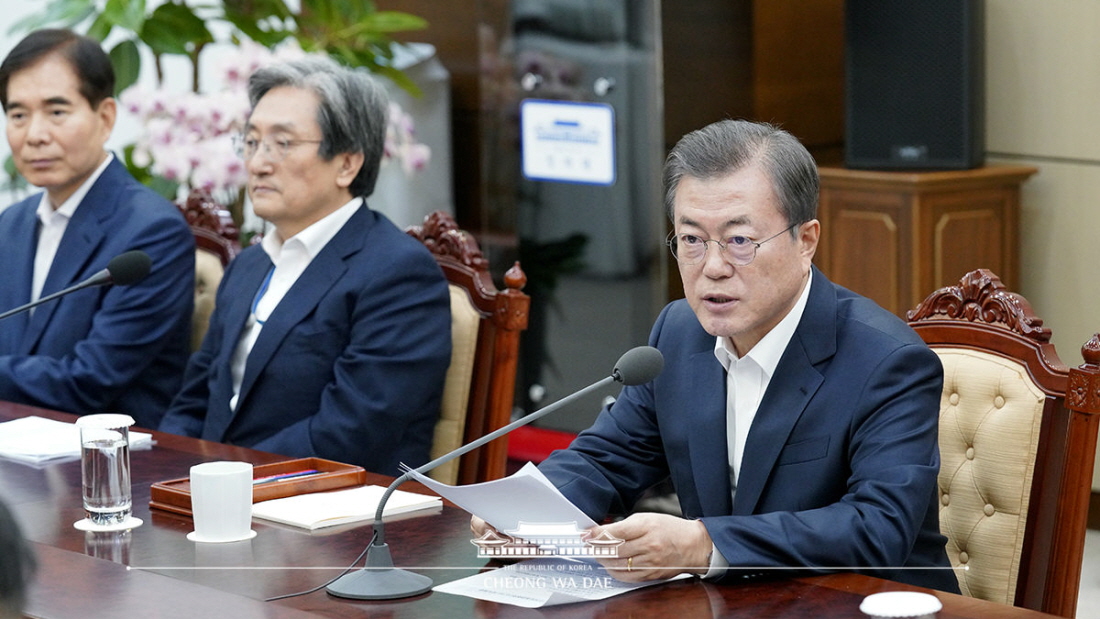이 웹사이트는 제19대 대통령 임기 종료에 따라 대통령기록관이 「대통령기록물 관리에 관한 법률」에 의해 이관받아 서비스하는 대통령기록물입니다. 자료의 열람만 가능하며 수정 · 추가 · 삭제는 불가능합니다.
다만, 「개인정보보호법」에 의하여 개인의 정보를 보호받기 원하시는 분은 관련 내용(요청자, 요청내용, 연락처, 글위치)을 대통령 웹기록물 담당자(044-211-2253)에게 요청해 주시면 신속히 검토하여 조치해 드리겠습니다. 감사합니다.
SPEECHES & REMARKS
BRIEFINGS
Opening Remarks by President Moon Jae-in at Meeting with His Senior Secretaries

Recently, a piece of news about a father and a son, dubbed Korea’s Jean Valjean, has touched the hearts of many people. The grocery store owner who forgave this pair of shoplifters, the police officer who shed tears when he bought them hot soup with rice before releasing them and the subsequent outpouring of support from compassionate citizens all testify to the fact that our society is one of warmth and hope. I am grateful to everyone. I urge the central and local governments not to rely on citizens’ kind support alone but to actively examine if the father and son can receive institutional help through welfare programs.
Despite a variety of difficulties, some positive changes to our economy are taking place. The Government has responded to such economic adversities as the global economic slowdown and protectionism by mobilizing all policy measures available to counter them.
We have worked to provide backing for economic vitality and growth through an expansionary fiscal policy, bringing hope that next year will be better than this one. What is all the more meaningful is that we’ve crafted these changes by maintaining and pursuing, without any wavering, the policy goals of innovation, inclusiveness and fairness instead of succumbing to the temptation to use the typical makeshift and artificial stimulus package chosen when the economy is in a downturn. We have to further accelerate such positive changes so that tangible government policy achievements reach the people. Only then will we be able to completely transform our economic fundamentals and help our economy take another leap forward.
More than anything else, employment indicators – a cause for concern at the beginning of this year – have markedly improved. The number of people employed has recently increased by more than 300,000 for four months in a row, and the employment rate has reached a record high. Both employment and unemployment rates for young people have seen drastic improvements as well. The number of those permanently employed has risen by nearly 600,000, and the number eligible for unemployment insurance has also significantly jumped, pointing to strong improvement in the quality of employment. All of this is a very meaningful accomplishment that reflects the Government’s persistent policy implementation that has focused on creating jobs and expanding the employment safety net.
In terms of the quality of jobs, however, there still remains much to be done. It is especially heartbreaking to see the continuing employment slump among those in their 40s, the main pillar of our economy. The Government cannot help but reflect on the extent of the policy efforts directed toward them in comparison to those directed at young people in their 20s and 30s, the “new middle-aged” in their 50s and the elderly in their 60s and over. The employment problems facing people in their 40s are mainly due to the sluggish manufacturing sector, but we just cannot afford to wait for that sector to recover.
When the Fourth Industrial Revolution goes into full swing, industrial restructuring could bring further upheaval in the jobs of those in their 40s. Continued “smartization” and automation at industrial sites may make it harder to hire them. The Government has been strengthening the employment safety net in preparation for changes in the industrial structure, but we urgently need special measures to deal with their employment. Just as we’ve provided intensive support for the employment of young people and the elderly, it is necessary to place employment measures for those in their 40s in a separate major policy category. I urge the Government to fully look into the economic and social circumstances that this group faces and formulate a customized employment support policy after examining the situation from various angles.
Changes in household income and how it is distributed also have special significance. According to relevant third-quarter trends this year, both income levels and its distribution have improved. Household incomes rose in all quintile income groups, including the poorest 20 percent who continue to make increasing gains. In particular, the general trend of widening income inequality was reversed thanks to improvements in the income quintile ratio: the distribution index indicated by the average income of the richest 20 percent of the population over that of the poorest 20 percent. It’s a truly meaningful change, given our current situation with the percentage of the working-age population shrinking as the population ages rapidly.
In order to further promote this change, it’s necessary to meticulously examine blind spots in the welfare system and carefully implement policies. In particular, special assessments and measures are needed for one-person households that are not included in the survey of household income trends. At about 30 percent, they account for the largest share of total households; this is not just because of population aging but because more and more people are marrying late or not at all. Given this circumstance, a comprehensive policy for one-person households is needed in various areas such as the economy, housing, social welfare and safety.
Income and distribution-related indices need to be upgraded to include one-person households so that relevant research and analysis can be conducted. Speaking of housing policies, we have to actively push ahead with a plan to expand the supply of housing in ways that meet demands from one-person households – in a departure from the previous standard that focused on four-person households. In particular, it is necessary to consider sufficient safety measures for one-person households made up of women.
Achievements in innovative growth are also a great hope for the future of our economy. Along with the Government’s intensive support, private-sector investment is also significantly expanding both in the three new industries of system semiconductors, biohealth and future cars and three main sectors – data, artificial intelligence and the hydrogen economy. Innovative startups and the spread of a second venture boom are very solid trends. The amount of investment in new business ventures is expected to surpass 4 trillion won this year. Amid a continued rise in the number of new corporations, the proportion of tech startups among new business ventures keeps increasing.
Notably, it is very significant that the number of unicorn companies – unlisted startups valued at over 1 trillion won – is rapidly growing. The number jumped from three at the launch of this Administration to 11 this year, and five unicorn companies emerged this year alone, showing that their numbers are growing at an accelerated rate. Korea ranks sixth in the world in terms of the number of unicorn companies and is now competing with Germany, which places fifth, with the difference being only one company. This demonstrates how Korea has formed a startup and business venture ecosystem that is on par with that of developed countries.
Local unicorn companies have been mostly platform or ICT-related firms so far, but – going one step further – the fact that the 11th unicorn company was created in the biohealth field is a positive change in the sense that these businesses are emerging from diverse sectors. The increase in the number of unicorn companies is a symbol of the success of Korea’s innovative growth policy. I ask the Government to do all it can to foster unicorn companies by taking a special interest and providing concentrated support.
I urge you to implement government policies as they are intended, for instance, by ensuring that intensive investments are made in prospective unicorn companies that have a high growth potential through the fund of funds and scale-up funds. In addition, the Government has to actively identify and strengthen support for companies that are highly likely to become unicorns in such Fourth Industrial Revolution fields as system semiconductors, future cars and bioengineering, as well as in the materials, parts and equipment industries so that unicorn companies can be created in more diverse areas.



